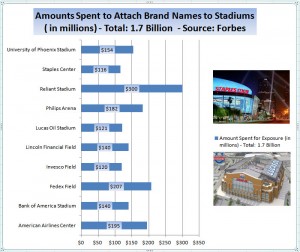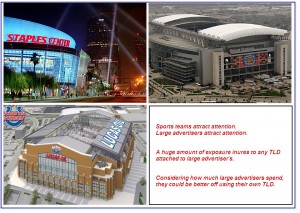Advertisers have given Verisign a free gift worth billions of dollars over the past 10 years.
Sports Stadiums provide a great analogy…
What do office supplies have to do with basketball? What does oil have to do with football?
Yet, Staples will pay the Lakers $116 million dollars and Lucas Oil will pay the Indianapolis Colts about the same (over 20 years) to associate their company names with these stadiums (1). These companies understand the value of an audience; the value of millions of eyeballs… and they gladly pay to have their brand viewed by millions of people even though those eyeballs are mostly interested in the sports.
Yet those same advertisers don’t consider the billions of dollars in aggregate cumulative advertising value that they are giving away for free… to Verisign when they advertise their dot.com domain names year after year after year on television, radio, billboards, and magazines… all around the world.
I’ve been trying to make the point on the value of new TLDs to advertisers for a long time and I think I can demonstrate it better by using the analogy of “sports stadium naming rights”. When you consider the amount of money spent on stadium naming rights it’s easy to see that smart brands consider it a successful strategy. In its simplest form, naming rights can be defined as the privilege of associating a sponsor’s name with a building, project, or event by including the sponsor’s name in the title of the item being named (2). Millions are spent on naming rights and are generally just a part of large brand ad budgets.
So here is the comparison: Although the ways and means are different it’s accurate to say that… sports teams attract attention… and large advertisers attract attention.
And a huge amount of valuable exposure inures to any TLD (.com / .net / .org / .whatever) that is attached to a large advertiser’s brand. Dot.com (Verisign) has been the primary recipient of that benefit… without question… for free… for at least ten years. If you wanted to take this analogy further, brands might even suggest that Verisign pay them to advertise .com as part of their brand name. Even with the benefits of a short URL, I’m actually a bit surprised at the reported amount ($350K) that Overstock paid for o.co (3). They could likely, easily acquire their own TLD next year for a bargain price of $185K. There is no doubt that the dot.co registry wants famous brands to use their TLD and that they are benefiting greatly by Overstock’s advertising dollars (The .co management team is one of the smartest and best in the domain name business).
All in all, considering the amounts that large brands spend on advertising every year, wouldn’t they just be better off using their own TLD? If brands used and advertised their own TLDs, all of their ad dollars would inure to their own brands, and the need to protect a brand across every possible TLD in existence would also be reduced. This is especially true since there are now so many legal and procedural processes in place to protect brands online anyway.
And with the barrier to entry that new TLDs provide (a cost of $185K) there is a clear and obvious long-term benefit to brands acquiring their own new TLDs.
Finally, consider Paul Stahura’s Circle ID article in 2009. Paul’s study showed that “the vast majority of trademark holders are not registering their trademarks in all the current generic TLDs, let alone all the TLDs.”(4) There is good reason for this. It doesn’t necessarily pay to register your famous brand in anything else except for the most used (most advertised) TLDs. The only TLDs that are “typed in” by end users with regularity are .com and .org, and a few of the most significant ccTLDs like .us, and .de; country codes of the largest commercial economies of the world. This is because they are the only ones that are widely advertised. People know about them and use them, so brands need to be protected under them.
But the need to register a brand under every possible new TLD will be greatly diminished in a world of dot.brands. I wish that the ANA and other trade groups would begin sharing the opportunities rather than telling their members that the sky is falling. It will be too late very soon.
To learn more about this topic, send for a copy of my free white paper on how brands can use new TLDs to stop cyber-squatters (5). Disclaimer: Yes, I work for a registry and have an interest in new TLDs, but I wouldn’t be promoting them if I didn’t think they were a fantastic idea for big brands.
Sources:
(1) http://www.forbes.com/2006/11/14/baseball-mets-citigroup-biz_cz_kb_1114naming_slide_2.html?thisSpeed=undefined
(2) http://cba.unomaha.edu/faculty/mohara/web/alsb01valuingnamingrights.pdf
(3) http://domainnamewire.com/2010/07/19/overstock-com-buys-o-co-for-350000/
(4) http://www.circleid.com/posts/20090202_analysis_domain_names_registered_new_gtlds/
(5) https://alagna.com/HowBrandsCanUseNewTLDSToStopCybersquatters-v3.pdf


